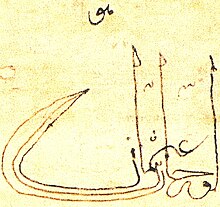
Back Toegra Afrikaans طغراء Arabic Tuğra Azerbaijani طوغرا AZB Тугра Byelorussian Тура Bulgarian তুগরা Bengali/Bangla Tugra BS Tughra Catalan Tugra Czech
This article needs additional citations for verification. (February 2024) |

A tughra (Ottoman Turkish: طغرا, romanized: ṭuġrā; Turkish: tuğra) is a calligraphic monogram, seal or signature of a sultan that was affixed to all official documents and correspondence. Inspired by the tamgha, it was also carved on his seal and stamped on the coins minted during his reign. Very elaborate decorated versions were created for important documents that were also works of art in the tradition of Ottoman illumination, such as the example of Suleiman the Magnificent in the gallery below.
The tughra was designed at the beginning of the sultan's reign and drawn by the court calligrapher or nişancı on written documents. The first tughra examples are from the 14th century.[1]
Tughras served a purpose similar to the cartouche in ancient Egypt or the Royal Cypher of British monarchs. Every Ottoman sultan had his own individual tughra.
- ^ "Tughra of Suleiman the Magnificent". The British Museum. 2010-05-14. 1949,0409,0.86. Archived from the original on 2010-09-18. Retrieved 2010-06-05.
© MMXXIII Rich X Search. We shall prevail. All rights reserved. Rich X Search